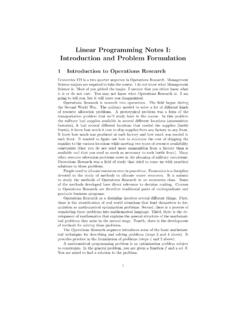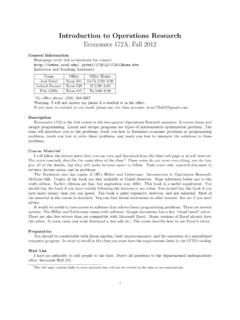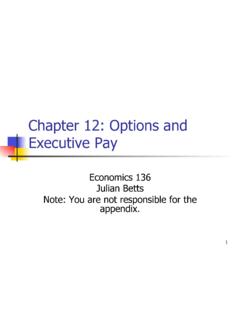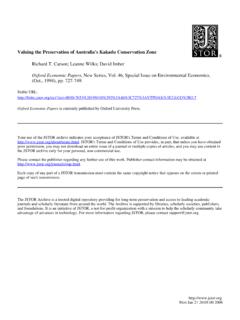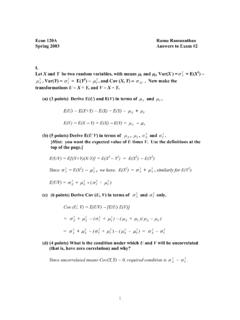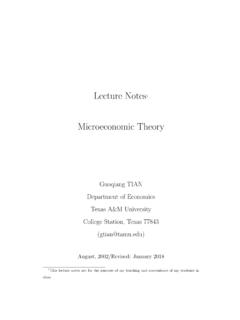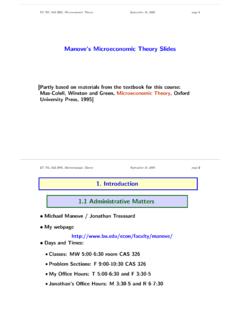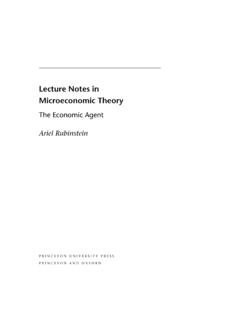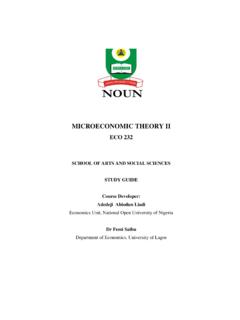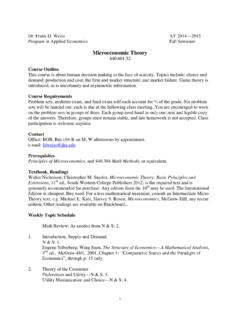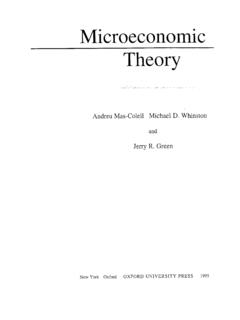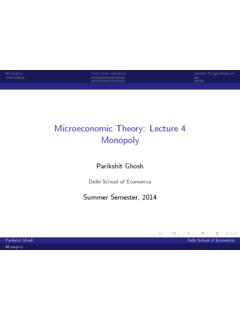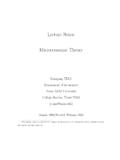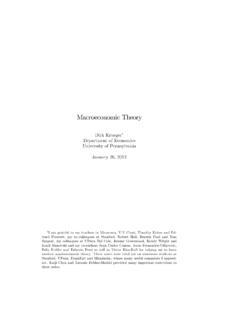Transcription of Microeconomic Theory - econweb.ucsd.edu
1 Practice Problems: First-Year M. Phil microeconomics , Consumer and Producer Theory Vincent P. Crawford, University of Oxford Michaelmas Term 2010. I start with a selection of problems from Mas-Colell, Whinston, and Green, Microeconomic Theory , Oxford, 1995 (note that some exercises are in the text within the chapters in which they appear): Preference and Choice Exercises Exercises Exercises Consumer Choice Exercises Exercises Exercises , 5-8, 10-12, 16-17. Classical Demand Theory Exercises Exercises Exercises Exercises Exercises Exercises , 14-15. Exercises Exercises , 3,5-6,9,11. Exercises Production Exercises , 6. Exercises , 8-13. Exercises , 5. Exercises Additional problems of my own (from various sources): Preference and Choice 1. (a) Suppose that an individual has lexicographic preferences over two variables, each of which is a good (that is, more of it is better). Are those preferences transitive?
2 Are they weakly monotone? Are they strongly monotone? Are they weakly convex? Are they strictly convex? Show why or why not in each case, using graphs if desired. (b) Answer part (a) again, but when x1 is a bad rather than a good (x2 is still a good). (c) Answer part (a) again, but for Leontief preferences in which both x1 and x2 are goods. 2. Prove that if a preference relation is not transitive, then it cannot be represented by a utility function. Consumer Choice and Classical Demand Theory 3. Compute my Walrasian/Marshallian and Hicksian demand functions when my utility function U(x1, x2, x3, x4) = min[x1+x2, x3+x4]. 4. Suppose that a consumer has utility function u(x1,x2) = ln x1 + 3x2 and faces a budget constraint p1x1 + p2x2 w, where p1, p2, w > 0 and x1,x2 0. (a) Find the consumer's expenditure function, e(p1,p2,u) and Hicksian demand functions, h1(p1,p2,u) and h2(p1,p2,u).
3 (Hint: For this utility function you may assume that h1(p1,p2,u). > 0 for all p1, p2, and u. Find the values of p1, p2, and u that yield solutions with h2(p1,p2,u) = 0 and with h2(p1,p2,u) > 0, and compute the solution in each case.). (b) What is the relationship between h1(p1,p2,u)/ p2 and h2(p1,p2,u)/ p1 when these partial derivatives exist? Compute the partial derivatives from your solutions for h1(p1,p2,u) and h2(p1,p2,u) in part (a), and verify directly that the relationship holds. (c) What are the units in which h1(p1,p2,u)/ p2 and h2(p1,p2,u)/ p1 are measured? Explain how those units can be the same (as is necessary given the relationship in (b)). even though the units of h1(p1,p2,u) and h2(p1,p2,u), and of p1 and p2, are generally different. 5. Consider the following system of Marshallian demand functions: x1(p1, p2, w) = aw/p1, x2(p1, p2, w) = (1-a)w/p2, where 0 < a < 1 and p1,p2 > 0.
4 (a) Which, if any, of the goods is a Giffen good? A normal good? An inferior good? A. luxury good? Explain. (b) Compute the Slutsky substitution matrix for these demand functions. Does it satisfy the symmetry condition that is necessary for consistency with utility maximization? Are its diagonal elements (the own substitution effects) negative? (c) Are the goods (Hicksian) complements or substitutes? Are the goods gross (Walrasian/Marshallian) complements or substitutes? (d) Assuming that the symmetry condition from part (b) is satisfied, explain how you would recover the consumer's direct utility function from his demand functions (but do not actually do it). 6. Consider an individual with an increasing, differentiable, strictly quasiconcave utility function U(x1,x2), and with differentiable compensated demand functions h1*(p1, p2, u). and h2*(p1, p2, u). If you know that h1*(17,17,1000)/ p1 = 50, what is the most you can say about the value of h2*(17,15,1000)/ p1, and the value of h1*(17,15,1000)/ u ?
5 7. Consider a consumer with preferences represented by a continuous, strictly increasing utility function, who maximizes utility subject to a budget constraint. In each case, the units of measurement are predetermined and do not change. (a) Suppose that after purchasing his original optimum, the consumer is given a coupon that entitles him to consume an extra free small unit (scale of units is fixed exogenously). of one commodity of his choice. Can you predict from price and quantity data only (without directly using preferences or the utility function) which commodity he will use the coupon on? (Be careful: first consider the case where all goods are purchased in positive amounts, and then the case where goods are not purchased in positive amounts.). (b) Suppose that the consumer is instead given a coupon that allows him to reduce the price of one of the commodities by a small amount per unit.
6 Can you predict from price and quantity data only on which commodity he will use the coupon? Does your answer in this case depend on whether all goods are purchased in positive amounts? (c) Suppose that the consumer is instead given a coupon that allows him to reduce the price of one of the commodities by a small percentage amount. Can you predict from price and quantity data only on which commodity he will use the coupon? Does your answer in this case depend on whether all goods are purchased in positive amounts? 8. If I have a linear utility function for two goods, and the slope of my Walrasian/Marshallian demand curve for the first good is 1 for some given values of p1, p2, and w, what can you say about the slope of my demand curve for the second good at these same values of p1, p2 and w? 9. Using budget lines and smooth, downward sloping, quasiconcave indifference curves in the (x1,x2) plane, illustrate the Slutsky decomposition of the effect of a rise in the price of commodity one upon my Walrasian/Marshallian demand for commodity two, in a situation where commodity two is an inferior good.
7 Give a verbal description/explanation of your illustration. 10. An individual maximizes a differentiable, strictly increasing utility function U(x1,..,xn). We do not know the utility function, nor can we directly measure the utility of any bundle, but we can observe how the consumer ranks any collection of bundles, and we can observe the consumer's ranking of as many bundles as we wish. In each case, either describe a test, or explain why no test could ever work: (a) Is it possible to empirically test the hypothesis that, holding all other commodity levels constant, the marginal utility of commodity one diminishes as its consumption level increases? (b) Is it possible to empirically test the hypothesis that, for any commodity levels, the marginal utility of commodity one plus the marginal utility of commodity two is always less than the marginal utility of commodity three? Production 11.
8 A firm has production function q = [min {x1, 3x2}]1/2 and faces output and input prices p, w1, w2 > 0. (a) Draw the input requirement set for q = 1. (b) Compute the firm's conditional factor demands, x1(w1,w2,q) and x2(w1,w2,q). (c) Compute the firm's cost function, c(w1,w2,q). (d) Assuming that the firm is a competitor in its output market, so that p is constant, compute its unconditional factor demands, x1(w1,w2,p) and x2(w1,w2,p); its supply function, q(w1,w2,p); and its profit function, (w1,w2,p). (e) Explain how you would compute the firm's optimal factor demands, supply, and profit when it is a monopolist in its output market, with given inverse demand function p = p(q). 12. If a production function F(L,K) is Leontief, what can you say about the scale properties ( , constant returns? increasing returns?) of its total cost function C(Q,w,r). Give a complete rigorous verbal answer, and do not write down any algebraic equations.
9 13. Could a production function have a long run expansion path which has, in part, a flat horizontal segment in the (L,K) plane? If so, what would this imply about the relationship between STC and LTC? Be as specific as possible. 14. A profit-maximizing firm uses only two inputs, x1 and x2, to produce a single output, q. Let w1 and w2 be the prices of the two inputs. Suppose that the firm's cost function is known to take the form c(w1,w2,q) a0 + a1q + a2w1q + a3w2q + a4(w1w2)1/2q, where the ai are parameters. (a) What restrictions on the ai correspond to the assumption that the firm's decisions are profit-maximizing? Explain. Does your answer depend on whether the profit-maximizing firm sells its output in a competitive market? Explain why or why not. (b) What restrictions on the ai in addition to those from part a (if any) correspond to the requirement that the firm's technology exhibits constant returns to scale?
10 Explain. (c) Under the restrictions on the ai imposed in (a) and (b), derive the firm's conditional factor demand functions. (d) Can you tell what the firm's production function is from the conditional factor demand functions derived in (c)? If so, do so.
